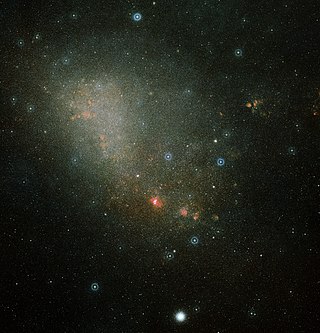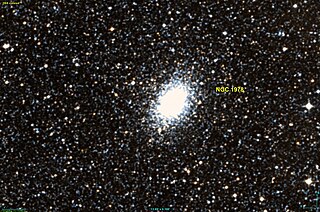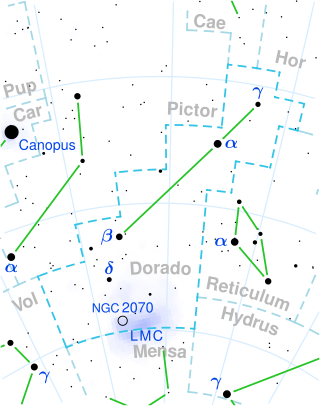
The Large Magellanic Cloud (LMC) is a dwarf galaxy and satellite galaxy of the Milky Way. At a distance of around 50 kiloparsecs (163,000 light-years), the LMC is the second- or third-closest galaxy to the Milky Way, after the Sagittarius Dwarf Spheroidal (c. 16 kiloparsecs (52,000 light-years) away) and the possible dwarf irregular galaxy called the Canis Major Overdensity. Based on the D25 isophote at the B-band (445 nm wavelength of light), the Large Magellanic Cloud is about 9.86 kiloparsecs (32,200 light-years) across. It is roughly one-hundredth the mass of the Milky Way and is the fourth-largest galaxy in the Local Group, after the Andromeda Galaxy (M31), the Milky Way, and the Triangulum Galaxy (M33).

The Small Magellanic Cloud (SMC) is a dwarf galaxy near the Milky Way. Classified as a dwarf irregular galaxy, the SMC has a D25 isophotal diameter of about 5.78 kiloparsecs (18,900 light-years), and contains several hundred million stars. It has a total mass of approximately 7 billion solar masses. At a distance of about 200,000 light-years, the SMC is among the nearest intergalactic neighbors of the Milky Way and is one of the most distant objects visible to the naked eye.
The Milky Way has several smaller galaxies gravitationally bound to it, as part of the Milky Way subgroup, which is part of the local galaxy cluster, the Local Group.

NGC 1818 is a young globular cluster in the north-west part of the Large Magellanic Cloud, about 3.2 kpc from the center. It was discovered by Scottish astronomer James Dunlop in 1826, and has since been well studied.

R136 is the central concentration of stars in the NGC 2070 star cluster, which lies at the centre of the Tarantula Nebula in the Large Magellanic Cloud. When originally named it was an unresolved stellar object but is now known to include 72 class O and Wolf–Rayet stars within 5 parsecs of the centre of the cluster. The extreme number and concentration of young massive stars in this part of the LMC qualifies it as a starburst region.

NGC 4449, also known as Caldwell 21, is an irregular Magellanic type galaxy in the constellation Canes Venatici, being located about 13 million light-years away. It is part of the M94 Group or Canes Venatici I Group that is relatively close to the Local Group hosting our Milky Way galaxy.

NGC 1755 is an open star cluster in the Large Magellanic Cloud in the Dorado constellation. It is about 120 light years across and due to its size could be a globular cluster. It has a diameter of 2.6′ and an apparent magnitude of 9.9. It was discovered by James Dunlop in 1826.

NGC 1466 is the New General Catalogue designation for a globular cluster in the deep southern constellation of Hydrus. It is located in the outskirts of the Large Magellanic Cloud, which is a satellite galaxy of the Milky Way. The object was discovered November 26, 1834 by English astronomer John Herschel. John Dreyer described it as "pF, pS, iR, glbM, *7 f", meaning "pretty faint, pretty small, irregular round, gradually a little brighter middle, with a 7th magnitude star nearby". When using a small telescope, this is a "faint, small, unresolved and difficult" target with an angular size of 1.9 arc minutes. It has an integrated visual magnitude of 11.4.

NGC 1978 is an elliptical shaped globular cluster or open cluster in the constellation Dorado. It is located within the Large Magellanic Cloud. It was discovered by James Dunlop on November 6, 1826. At an aperture of 50 arcseconds, its apparent V-band magnitude is 10.20, but at this wavelength, it has 0.16 magnitudes of interstellar extinction. It appears 3.9 arcminutes wide. NGC 1978 has a radial velocity of 293.1 ± 0.9 km/s.

NGC 708 is an elliptical galaxy located 240 million light-years away in the constellation Andromeda and was discovered by astronomer William Herschel on September 21, 1786. It is classified as a cD galaxy and is the brightest member of Abell 262. NGC 708 is a weak FR I radio galaxy and is also classified as a type 2 Seyfert galaxy.

NGC 1428 is a peculiar galaxy of an uncertain morphology; either an elliptical or lenticular galaxy located approximately 65 million light-years away from Earth.

NGC 4324 is a lenticular galaxy located about 85 million light-years away in the constellation Virgo. It was discovered by astronomer Heinrich d'Arrest on March 4, 1862. NGC 4324 has a stellar mass of 5.62 × 1010M☉, and a baryonic mass of 5.88 × 1010M☉. The galaxy's total mass is around 5.25 × 1011M☉. NGC 4324 is notable for having a ring of star formation surrounding its nucleus. It was considered a member of the Virgo II Groups until 1999, when its distance was recalculated and it was placed in the Virgo W Group.

NGC 1396 is a dwarf elliptical galaxy located 61 million light years away in the constellation of Fornax. The galaxy was discovered by astronomer Julius Schmidt on January 19, 1865, and is a member of the Fornax Cluster. Despite the fact that the galaxy PGC 13398 is most commonly identified as NGC 1396, there is uncertainty in its identification.

HD 271182, occasionally referred to as G266 and R92, is a rare yellow hypergiant (YHG) and an Alpha Cygni variable. It is one of the brightest stars in the Large Magellanic Cloud (LMC), positioned in the deep southern constellation of Dorado. Gaia DR2 parallax measurements indicate that it is located around 200,000 light-years away, though this value is extremely uncertain. Despite this vast distance from Earth, the star is observable through a small telescope due to its immense luminosity, at an apparent magnitude of 9.6. It is receding away from the Sun at a heliocentric radial velocity of +311.9185 km/s, confirming its membership in the LMC.














